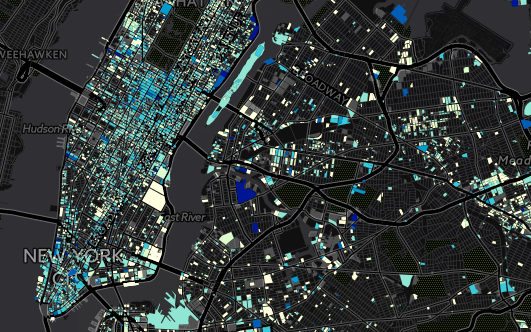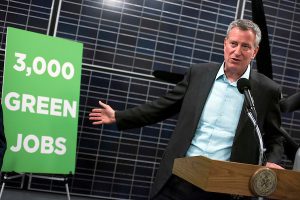Tag: 80-x-50
March 3, 2019
Can NYC’s Energy Use Data Save The Earth?
By Warren Berger On Earth Day 2015, New York City Mayor Bill de Blasio announced One New York City: The Plan for a Strong and Just City (OneNYC). As part of the plan, Mayor de Blasio committed New York City to reduce carbon emissions by 80 percent by 2050 from 2005 levels (80 x 50), with an interim target to reduce emissions 40 percent by 2030 (40 x 30). But meeting those targets requires a good understanding of where the City’s emissions come from. New York City Buildings cause 75% of New York City’s carbon emissions. The residential sector accounts for 37 percent of the City’s total emissions, making it the largest single source of emissions in the City. Collecting energy use data in these buildings is certainly a good place to start, but will that be enough to meet the City’s aggressive goals and address the climate change challenge in time?
On Earth Day 2015, New York City Mayor Bill de Blasio announced One New York City: The Plan for a Strong and Just City (OneNYC). As part of the plan, Mayor de Blasio committed New York City to reduce carbon emissions by 80 percent by 2050 from 2005 levels (80 x 50), with an interim target to reduce emissions 40 percent by 2030 (40 x 30). But meeting those targets requires a good understanding of where the City’s emissions come from. New York City Buildings cause 75% of New York City’s carbon emissions. The residential sector accounts for 37 percent of the City’s total emissions, making it the largest single source of emissions in the City. Collecting energy use data in these buildings is certainly a good place to start, but will that be enough to meet the City’s aggressive goals and address the climate change challenge in time?
According to the New York State Energy and Research and Development Authority (NYSERDA) report, Realizing Measurable Savings in Multifamily Building: Results from NYSERDA’s Multifamily Performance Program:
“It is critical to the growth of the energy efficiency market that we improve the accuracy of savings predictions to decrease the risk involved with investing in efficiency. The first step in doing so is to track and analyze actual savings data to discover changes that practitioners or program administrators can make to improve the accuracy of savings predictions and to discover which factors cannot be changed so that building owners and investors better understand the inherent risks and the likelihood of project success.”
Local Laws Aim to Capture Energy Use Data New York City’s Local Law 84 of 2009 (LL84) requires annual benchmarking data to be submitted by owners of buildings with more than 50,000 square feet for public disclosure, creating transparency for energy and water usage and informing building owners and tenants on how to make their buildings more efficient. Local Law 133 of 2016 (LL133) expands the list of buildings required to benchmark to include mid-size buildings from 25,000 to 50,000 square feet. Local Law 87 of 2009 (LL87) requires covered buildings spanning 50,000 square feet or more to audit their energy consumption and conduct retro-commissioning of building systems, including the building envelope, boiler, domestic hot water, ventilation and lighting. Compliance is Complex What has the data collection process taught us about what it takes to motivate action and effect change in the city’s residential buildings? For one thing, it’s clear from benchmarking extensions that gaining compliance isn’t a simple matter. Early last year, the City announced a deadline extension for submission of 2017 benchmarking reports for mid-sized buildings to December 31, 2018. In September 2018, the deadline was extended again, this time to February 1, 2019. In 2018, the New York City Department of Buildings and the NYC Benchmarking Help Center publicized three walk-in help sessions, which took place in May, October and November, for building owners who want more information about compliance. The center also maintains a telephone and e-mail service for owners who want more information, assistance, and answers to questions about the NYC Benchmarking Law. (more…)
